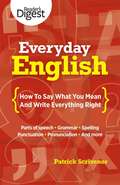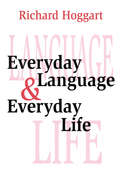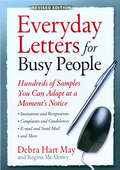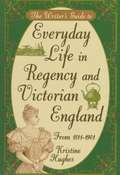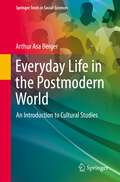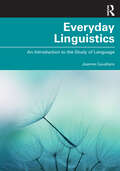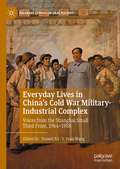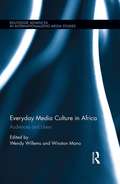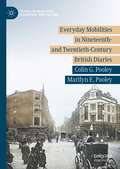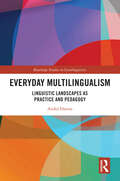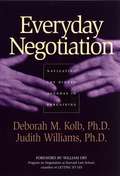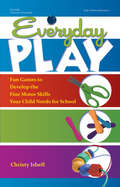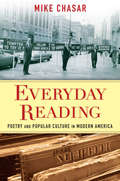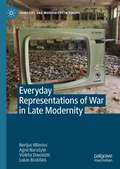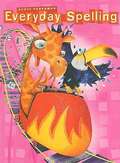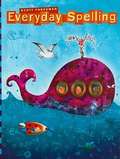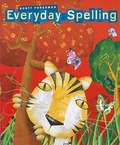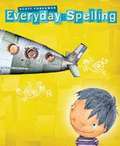- Table View
- List View
Everyday Ecofascism: Crisis and Consumption in American Literature
by Alexander MenriskyA timely look into how fascist ideas permeate contemporary culture well beyond the far right As challenges posed by climate change have intensified in the twenty-first century, right-wing figures in the United States and abroad have increasingly framed anti-immigrant, anti-Indigenous, and white-supremacist sentiments in terms of environmental survival. Everyday Ecofascism explores the insidious nature of this tendency, revealing how permutations of these perspectives in fact resonate across the political spectrum. Drawing on comparative studies of fascism writ large, Alexander Menrisky demonstrates that ecofascism is best understood not as a uniquely right-wing ideology but as a political genre that reinforces white supremacy and other forms of domination. Presenting a view of fascism as a complex power network that plays out on scales both large and small, Menrisky shows how extremist sentiments have crept into everyday language, stories, and ideas. Through a literary and cultural studies lens, he illuminates ecofascism&’s narrative patterns and their easy permeation of environmentalist discourses, from back-to-the-land movements to the resurgence of psychedelic drugs, food localism, and pandemic politics. Opposite his analysis of ecofascism in action, Menrisky sheds important light on narrative resistances to dominant conceptions of race, nation, and territory by Native, queer, and women-of-color writers who have countered ethnonationalism for generations. Bridging past and present, Menrisky powerfully nails down the emergent concept of ecofascism and forms a basis for understanding phenomena like Covid-19, ecological utopianism, and psychedelic environmentalism that detangles ecofascist tendencies from justice-oriented visions of place-based belonging. Retail e-book files for this title are screen-reader friendly.
Everyday English
by Patrick ScrivenorDo you puzzle over participles, argue over agreement, or throw up your hands over the comma? This back-to-basics overview of the English language includes just what you need to know to make a great impression every day--in school, in life, online, and on the job. Each chapter, covering all the essentials from parts of speech to pronunciation to common pitfalls, includes concise, easy-to-find definitions and explanations, countless examples, fun facts, and tips. · Parts of Speech: Nouns, verbs, adjectives, and more form the building blocks of the English language. Don't get tripped up by tenses, possessive pronouns, or adverbs ever again.· Grammar: From the simplest sentences to the most complex, this quick guide to grammar shows how to construct phrases and clauses, fix fragments, maintain subject-verb agreement, and so much more.· Spelling and Pronunciation: Avoid embarrassing gaffes and typos with this guide to common spellings, vowel and consonant sounds, and word stress.· Punctuation: Eggs or egg's, the Smiths or the Smith's (or the Smiths')--proper punctuation makes all the difference. Never misplace another comma, misuse another apostrophe, or mistake another semicolon for an ink smudge.· Clear Usage: Create sparkling sentences by using ten key principles of great writing, such as Don't use no double negatives, Steer clear of clichés, and It is thought that using passive voice should be avoided. (CK final keys)· Pitfalls and Confusions: Avoid misunderstandings with this handy li
Everyday Evil in Stephen King's America: Essays, Images, Paratexts
by Jason S Polley Stephanie Laine HamiltonThis edited collection variously interrogates how everyday evil manifests in Stephen King’s now-familiar American imaginary; an imaginary that increases the representational limits of both anticipated and experienced realism. Divided into three parts: I. The Man, II. The Monster, and III. The Re-mediator, the book offers rigorous readings of evil, realism, and popular culture as represented in a range of texts (and paratexts) from the King canon. Rich with images, a photo-essay, and appendices collecting classical texts and cultural detritus germane to King, this book moves away from viewing King’s work primarily through the lens of the “American gothic” and toward the realism that the suspense novelist’s voice (fictional and non-) and influence (literary and popular) indelibly continue to amplify, all the while complicating the traditional divide between serious literature and popular fiction.Stephen King remains perpetually popular. And he is finally receiving the academic treatment he has craved since the early 1980s. Yet still unexamined in the King critical canon is the suspense novelist’s fascination with “everyday evil.” Beyond rigorous interrogations of King’s fictional depictions of “everyday evil” by an array of scholars of different ranks living around the world (Canada, Finland, Hong Kong, the UK), the book, replete with 20 images, considers how King widens the parameters of literary production and appreciation. An integral part of the Americana that King’s five-decades-in-the-making canon configures, of course, includes King himself. King has long made use of self-referentiality in his fiction and nonfiction. Some of his nonfiction, several of our essays reveal, recirculates in paratextual form as “Prefatory Remarks” to new novels or new editions of older ones. The paratexts considered here (both across the volume and in the appendices) offer alternate ways by which to appreciate King and his sphere of influence (literary and popular). Said appendices are a grouping of King's paratexts on his writing as Bachman, appearing here, for the first time, as a cohesive collection. King's influence took off in the 1970s, as is further explored in the book-enveloping three-part photo-essay “King’s America, America’s King: Stephen King & Popular Culture since the 1970s.” About the transformative quality of “everyday evil,” the photo-essay tracks the cultural impacts of King first as an emerging author, then a pop culture phenomenon, and, finally, as an established American literary voice.Everyday Evil in Stephen King's America is designed to appeal to teachers and students of American literature, to Stephen King enthusiasts, as well as to acolytes of Americana since the Vietnam War.
Everyday Inventions (Reach Into Phonics Ser.)
by Deborah J. Short Felix Quintos Gertrude FleckNIMAC-sourced textbook
Everyday Language and Everyday Life
by Richard HoggartFor years Richard Hoggart has observed the oddity of a common speech habit: the fondness for employing ready-made sayings and phrasings whenever we open our mouths, a disinclination to form our own sentences "from scratch," unless that becomes inescapable. But in this book he is interested in more specific questions. How far do the British, and particularly the English, share the same sayings across the social classes? If each group uses some different ones, are those differences determined by location, age, occupation or place in the social scale? Over the years, did such sayings indicate some of the main lines of their culture, its basic conditions, its stresses and strains, its indications of meaning, and significance? These and other concerns animate this fascinating exploration of how the English, and particularly working-class English, use the English language.Hoggart sets the stage by explaining how he has approached his subject matter, his manner of inquiry, and the general characteristics of sayings and speech. Looking back into time, he explores the idioms and epigrams in the poverty setting of the early working-class English. Hoggart examines the very innards of working-class life and the idioms, with the language that arose in relation to home, with its main characters of wives and mothers, husbands and fathers, and children; the wars; marriage; food, drink, health, and weather; neighbors, gossip, quarrels, old age, and death. He discusses related idioms and epigrams and their evolution from prewar to present.Hoggart identifies the sayings and special nuances of the English working-class people that have made them identifiable as such, from the rude and obscene to the intellectual and imaginative. Hoggart also examines the areas of tolerance, local morality, and public morality, elaborating on current usage of words that have evolved from the fourteen through the eighteenth centuries. He touches on religion, superstition, and time, the beliefs that animate language. And finally, he focuses on aphorisms and social change and the emerging idioms of relativism, concluding that many early adages still in use seem to refuse to die.With inimitable verve and humor, Hoggart offers adages, apothegms, epigrams and the like in this colorful examination drawn from the national pool and the common culture. This volume will interest scholars and general readers interested in culture studies, communications, and education.
Everyday Letters for Busy People: Hundreds Of Samples You Can Adapt At A Moment's Notice
by Debra Hart May Regina McAloneyNow revised and updated: Hundreds of tips, techniques, and samples to help you write the perfect letter (or e-mail) no matter what the occasion.A text message may be fast—but sometimes only a letter will do. Writing a good letter takes time and thought, but there are ways to make the process faster, easier, and more effective.With Everyday Letters for Busy People as your guide, you can write the kind of letters that get action, build relationships, ease tense situations, and get your message across. Everyday Letters for Busy People includes a wide variety of sample letters you can use or adapt at a minute’s notice including:Business letters • Complaint letters • Community action letters • Job-search letters • Letters to government officials and agencies • Thank-you letters • Invitations • Condolences • Resignations and many moreWith a new section on how to write concise, polite, and effective e-mails, Everyday Letters for Busy People will not only help you compose the sharpest interview follow-up, the kindest thank you, the most heartfelt condolence, and the most effective complaint letter, it will also direct you in proper letter etiquette and help you become a better writer.
Everyday Life In Regency And Victorian England (The Writer's Guide To Everyday Life Ser.writer's Guide To Everyday Life Series)
by Kristine HughesIn this timesaving reference book, respected author and historian Kristine Hughes brings 19th century England to life as she leads you through the details that characterize this fascinating era. From slice-of-life facts, anecdotes and firsthand accounts, to sweeping timelines and major historical events, this guide presents the delightful and often surprising daily realities of Regency and Victorian England. With it, you'll craft a vibrant story as you learn what people ate, from pigeon pie and turtle dinners to syllabub and milk punch, where a prisoner would go if he were remanded to the "hulks; " the four coats a gentleman must have in his wardrobe, and other fashion requirements of the era; the rules honored by decent society, from the proper way to promenade to the polite hours to "call; " how couples married and divorced, through churching, wife-selling and other practices; what people did for work, from cottagers and climbing boys to milkmaids and manservants; the meaning of common slang words like mawleys and moleskins; what Cook's Tours were life and where they could take the adventurous; and trends in entertainment, such as dandies, panoramas and more.
Everyday Life in the Postmodern World: An Introduction to Cultural Studies (Springer Texts in Social Sciences)
by Arthur Asa BergerThis introductory textbook familiarizes students with ideas of key thinkers and perspectives related to postmodern thought and everyday life. The book is unique in that it offers selections from key passages of works of important thinkers as well as from some of the author's own publications that serve as examples of how to interpret various aspects of culture. The book draws in readers with its engaging and conversational style and use of cases, illustrations and photographs, including fun discussions on everyday life under pandemic restrictions. This is a must read for students taking courses in sociology, cultural anthropology, culture and media studies, linguistics, social philosophy, and for specific courses on postmodernism.
Everyday Linguistics: An Introduction to the Study of Language
by Joanne CavallaroThis innovative introduction to linguistics connects language structure to everyday use, culture, and context, making the technicalities of language structure accessible, vivid, and engaging. The first text to take a socially realistic linguistics approach, this exciting new textbook situates discussions about the building blocks of language like phonetics, syntax, and pragmatics within a social justice framework that recognizes that all language is shaped by sociocultural forces and reveals and reinforces ideologies. Uniquely, this text also introduces ecolinguistics, a new field that examines the relationship between language and its environment, again demonstrating how widely held views about language can have real-world consequences. Key features include: "Linguistics in your world" sections to connect concepts discussed with specific social issues "L1 acquisition in focus" sections to relate key concepts to first language acquisition "Explorations" sections at the end of each chapter to encourage students to test their knowledge, discuss in groups, and apply what they have learned to their own experiences End-of-chapter summaries and key term lists to conclude the main lessons and highlights of each chapter Recommendations for further reading Everyday Linguistics: An Introduction to the Study of Language is an ideal starting point for students that are new to the study of language, and those not majoring in language study.
Everyday Linguistics: An Introduction to the Study of Language
by Joanne CavallaroThis innovative introduction to linguistics connects language structure to everyday use, culture, and context, making the technicalities of language structure accessible, vivid, and engaging. The first text to take a socially realistic linguistics approach, this exciting new textbook situates discussions about the building blocks of language like phonetics, syntax, and pragmatics within a social justice framework that recognizes that all language is shaped by sociocultural forces and reveals and reinforces ideologies. Uniquely, this text also introduces ecolinguistics, a new field that examines the relationship between language and its environment, again demonstrating how widely held views about language can have real-world consequences. Key features include: "Linguistics in your world" sections to connect concepts discussed with specific social issues "L1 acquisition in focus" sections to relate key concepts to first language acquisition "Explorations" sections at the end of each chapter to encourage students to test their knowledge, discuss in groups, and apply what they have learned to their own experiences End-of-chapter summaries and key term lists to conclude the main lessons and highlights of each chapter Recommendations for further reading Everyday Linguistics: An Introduction to the Study of Language is an ideal starting point for students that are new to the study of language, and those not majoring in language study.
Everyday Lives in China's Cold War Military-Industrial Complex: Voices from the Shanghai Small Third Front, 1964-1988 (Palgrave Studies in Oral History)
by Y. Yvon Wang Youwei XuThis book translates and contextualizes the recollections of men and women who built, lived, and worked in some of the factory compounds relocated from China’s most cosmopolitan city—Shanghai. Small Third Line factories became oases of relatively prosperous urban life among more impoverished agricultural communities. These accounts, plus the guiding questions, contextual notes, and further readings accompanying them, show how everyday lives fit into the sweeping geopolitical changes in China and the world during the Cold War era. Furthermore, they reveal how the Chinese Communist Party’s military-industrial strategies have shaped China’s economy and society in the post-Mao era. The approachable translations and insight into areas of life rarely covered by political or diplomatic histories like sexuality and popular culture make this book highly accessible for classroom use and the general-interest reader.
Everyday Media Culture in Africa: Audiences and Users (Routledge Advances in Internationalizing Media Studies)
by Wendy Willems Winston ManoAfrican audiences and users are rapidly gaining in importance and increasingly targeted by global media companies, social media platforms and mobile phone operators. This is the first edited volume that addresses the everyday lived experiences of Africans in their interaction with different kinds of media: old and new, state and private, elite and popular, global and national, material and virtual. So far, the bulk of academic research on media and communication in Africa has studied media through the lens of media-state relations, thereby adopting liberal democracy as the normative ideal and examining the potential contribution of African media to development and democratization. Focusing instead on everyday media culture in a range of African countries, this volume contributes to the broader project of provincializing and decolonizing audience and internet studies.
Everyday Mobilities in Nineteenth- and Twentieth-Century British Diaries (Studies in Mobilities, Literature, and Culture)
by Colin G. Pooley Marilyn E. PooleyThis book uses diaries written by ordinary British people over the past two centuries to examine and explain the nature and extent of everyday mobilities, such as travel to school, to work, to shop or to visit friends, and to explore the meanings attached to these mobilities. After a critical evaluation of diary writing, the ways in which mobility changed over time, interacted with new forms of transport technology, and varied from place to place are examined. Further chapters focus on the roles of family and life course, gender, income and class, and journey purpose in shaping mobilities, including immobility. It is argued that easy and frequent everyday mobilities were experienced by most of the diarists studied, that travellers could exercise their own agency to adapt easily to new forms of transport technology, but that factors such as gender, class, and location also created significant mobility inequalities.
Everyday Multilingualism: Linguistic Landscapes as Practice and Pedagogy (Routledge Studies in Sociolinguistics)
by Anikó HatossHatoss explores multilingualism in diverse suburbs of Sydney through the oral and written narratives of student ethnographers. Her research is based on visual ethnography, interviews with local residents and classroom discussions of the fieldwork. The findings of this book contribute to the scholarship of sociolinguistics of globalisation and seek to enhance our understanding of the complex interrelationship between the linguistic landscape and its participants: how language choices are negotiated, how identity and ideologies shape interactions in everyday contexts of the urban landscape. The narrative approach provides a multi-layered analysis to better understand the micro and macro connections shaping everyday interactions, conviviality and social relations. Hatoss offers methodological and pedagogical insights into the development of global citizenship and intercultural competence through the experiential learning provided by the linguistic landscape project. This volume is a useful source for researchers working in diverse fields of multilingualism, diaspora studies, narratives and digital ethnographies in sociolinguistics. It offers methodological insights to the study of urban multilingualism and pedagogical insights into using linguistic landscapes for developing intercultural competence.
Everyday Negotiation
by Deborah M. Kolb Judith WilliamsEveryday Negotiation shows how to recognize the shadow negotiation-- where the unspoken attitudes, hidden assumptions, and conflicting agendas that drive the bargaining process play out--and how to put that knowledge to work. Originally titled The Shadow Negotiation and named by Harvard Business Review as one the Ten Best Books of 2000, this best-selling book revealed how women could master the hidden agendas that determine bargaining success. Now,the new edition, Everyday Negotiation, broadens the scope and offers the same illuminating advice for both men and women. Everyday Negotiation lays out simple steps to * Overcome acts of self-sabotage * Increase your bargaining power * Establish the terms of your advocacy and encourage a collaborative discussion * Encourage a collaborative discussion * Think about the negotiation process in a whole new way
Everyday Play: Fun Games to Develop the Fine Motor Skills Your Child Needs for School
by Christy IsbellDevelop the fine motor skills your child needs for school success! Fine motor skills are a stepping-stone for school readiness, and Everyday Play gives you the tools you need to make developing those skills easy and fun! Organized by age for easy reference, the dozens of creative activities in Everyday Play are inexpensive, require few or no materials, and are easy to do with your child. Best of all, they give you and your child great ways to have fun while laying the foundation for important fine motor skills that your child needs for school. Activities include: * No-Mess Finger Painting * Marble Painting * Racing Tracks * Squeezy Water Play * Graph Paper Art * Water Droppers Holding a pencil, drawing a line, zipping a coat-- Everyday Play helps your child accomplish all these milestones and more. With a chapter of frequently asked questions from real parents, developmental guidelines, and easy strategies for teaching your child important skills, Everyday Play is the book you need to ensure your child is ready for school.
Everyday Reading: Poetry and Popular Culture in Modern America
by Mike ChasarEveryday Reading is the first full-length critical study of the culture surrounding American popular and commercial poetry in the twentieth century.
Everyday Reading: Poetry and Popular Culture in Modern America
by Mike ChasarExploring poetry scrapbooks, old-time radio show recordings, advertising verse, corporate archives, and Hallmark greeting cards, among other unconventional sources, Mike Chasar casts American poetry as an everyday phenomenon consumed and created by a vast range of readers. He shows how American poetry in the first half of the twentieth century and its reception helped set the stage for the dynamics of popular culture and mass media today. Poetry was then part and parcel of American popular culture, spreading rapidly as the consumer economy expanded and companies exploited its profit-making potential. Poetry also offered ordinary Americans creative, emotional, political, and intellectual modes of expression, whether through scrapbooking, participation in radio programs, or poetry contests. Reenvisioning the uses of twentieth-century poetry, Chasar provides a richer understanding of the innovations of modernist and avant-garde poets and the American reading public's sophisticated powers of feeling and perception.
Everyday Representations of War in Late Modernity (Identities and Modernities in Europe)
by Violeta Davoliūtė Nerijus Milerius Agnė Narušytė Lukas BrašiškisThis book analyses photographic and cinematographic representations of war and its memorialisation rituals in the period of late modernity from the perspectives of cultural sociology, philosophy, art theory and film studies. It reveals how the experience of war trauma takes root in everydayness and shows how artists try to question the ‘normality’ of the everyday, to actualise the memory of war trauma, to rethink the contrasting experiences of the time of war and everydayness, and to oppose the imposed historical narratives. The new representations are analysed by developing theories of war as a ‘magic spectacle’, also by using such concepts as spectres, triumph and trauma, collective social catastrophes, forensic architecture and others.
Everyday Saints and the Art of Narrative in the South English Legendary
by Anne B. ThompsonAnne Thompson here gives the fullest account and explanation to date of the diversity of the more than sixty manuscripts of the South English Legendary, a late thirteenth-century collection of lively verse lives of saints, in a southern English dialect. The importance of the SEL to hagiographic and cultural studies has been increasingly acknowledged in recent years. Without denying the legendaries’ religious purpose, this book looks at the way SEL narratives reflect and address the complex, interwined tapestry”political, social, religious”of Edward I’s England, while retaining a strong emphasis on the craft of story-telling. Thompson shows the SEL to be a fresh and exciting early example of popular vernacular literature. Firmly grounded in rural and small town life of the 1270s to 1290s in the west of England, it is uniquely significant for any understanding of that culture.

